Mimidae • Motacillidae • Bombycillidae • Laniidae • Sturnidae • Vireonidae • Parulidae
This list contains pictures of birds found on the official Louisiana Checklist. These birds were photographed within the state except where noted. Birds marked with an asterisk (*) are currently on the review list of the Louisiana Bird Records Committee.
Order PASSERIFORMES
Family Mimidae - Mockingbirds, Thrashers, and Allies
| |
Gray Catbird |
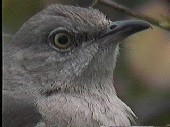
|
Northern Mockingbird |
| |
Sage Thrasher * |
| |
Brown Thrasher |
| |
Curv-billed Thrasher * |
Family Motacillidae - Pipits
| |
White Wagtail *
The Least Grebe was first reported in the state on Dec. 14, 1947, in Baton Rouge. Subsequent to that sighting, the only other report of the species that I am
familiar with took place in Cameron Parish, at Mud Lake, on Feb. 11, 1978. The bird shown here was filmed in a more reliable location for the species, at
Santa Ana NWR in the Lower Rio Grande Valley. |
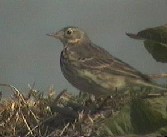
|
American Pipit |
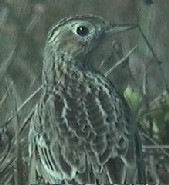
|
Sprague's Pipit
Sprague's Pipit seems to be a species that field guide artists have a problem with. Most portray it as though it were a grassland version of a Water Pipit.
In reality, the Sprague's resembles the Water Pipit very little in features or habitat preferences. With its small head and long neck atop a plump body
the color of dry grass, Sprague's is reminiscent of a minute Buff-breasted or Upland Sandpiper. In terms of habitat, it seeks out the same short grass
situations as those two shorebirds, rather than the wet, bare fields or beaches that Water Pipits frequent. An interesting contrast can be seen on Rutherford
Beach, in Cameron Parish. There, a small group of Sprague's can be found every year, feeding in the well-grazed grasslands adjacent to the beach.
Occasionally, Water Pipits can be seen within just a few feet of a Sprague's, but on the open sand at the Gulf's edge.
When flushed, a Sprague's will call loudly while launching itself aloft, then will often fly in a huge, leisurely circle for a few minutes before
returning to the ground. The best way to get a good look at one perched is to hurry to the spot where it landed, then scan the area well before it can
walk too far away. |
Family Bombycillidae - Waxwings
Family Laniidae - Shrikes
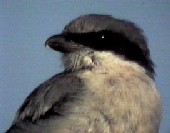
|
Loggerhead Shrike |
Family Sturnidae - Starlings
Family Vireonidae - Vireos
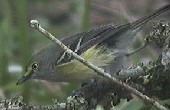
|
White-eyed Vireo |
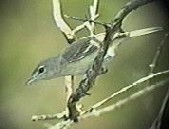
|
Bell's Vireo *
In Lousiana, Bell's Vireo is a rare (apparently intermittent) breeder, a rarely observed fall migrant, and a rare winterer. Breeding has been noted
in the past in the extreme northwestern corner of the state, and also near Monroe, but neither of these areas has sustained a population for more than a
few years. There are 6 fall records, extending from August 26 to September 26. The 13 winter records extend from 4 November to Mar 9, although this last
date may pertain to an early spring migrant. The bird pictured here was present from Feb 25-Mar 5, 1995, near Kaplan, Vermilion Parish.
For an excellent summary of the staus of vireos in Louisiana, consult:
Timing of Migration and Status of Vireos in Louisiana, J.V. Remsen, Jr., S.W. Cardiff, and D.L. Dittmann. Journal of
Field Ornithology 67(1):119-140. |

|
Solitary Vireo
Solitary Vireo is a fairly common but not always conspicuous winter resident in SW Louisiana. The earliest migrants generally begin to arrive by late
September; from this time, they are present through about mid-April. Solitary Vireo is a somewhat late migrant, and their numbers may possibly peak in
December (Remsen et al., 1996). Winterers are generally gone by late March, though migrants continue to pass through the area in small numbers through
early April. The extreme fall date is Sept. 4, though the next earliest arrival is a Sept 20 record that may pertain to the western
"Cassin's" subspecies. The extreme late date for spring is a bird recorded on May 11.
For an excellent summary of the staus of vireos in Louisiana, consult:
Timing of Migration and Status of Vireos in Louisiana, J.V. Remsen, Jr., S.W. Cardiff, and D.L. Dittmann. Journal of Field Ornithology
67(1):119-140. |
| |
Plumbeous Vireo * |
| |
Yellow-throated Vireo |
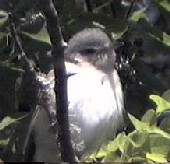
|
Warbling Vireo |
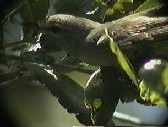
|
Philadelphia Vireo
Philadelphia Vireo is a common late spring migrant along the coast, and common fall migrant both inland and coastally. Fall migration extends from
late September to November, peaking in October. Spring migration dates extend from April 20 to May 21, with a peak in late April-early May.
Philadelphia Vireos are encountered frequently along the coast during the peak of their spring passage, especially during "fallouts",
but spring records north of the coast are almost nonexistent. (Remsen et al. 1996). Although vireos are generally seen feeding by gleaning insects
from leaves, Philadelphia Vireos have been observed feeding on the fruit of Virginia Creeper, (Parthenocissus quinquefolia), in Southwestern LA in
fall. At least two Philadelphias were observed making frequent visits to one such vine from October 12-18, 1994, at Acadiana Park, Lafayette.
For an excellent summary of the staus of vireos in Louisiana, consult:
Timing of Migration and Status of Vireos in Louisiana, J.V. Remsen, Jr., S.W. Cardiff, and D.L. Dittmann. Journal of Field Ornithology 67(1):119-140.
Similar Species: Bell's Vireo, Warbling Vireo, Red-eyed Vireo |
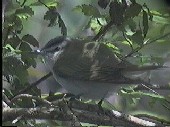
|
Red-eyed Vireo |
| |
Yellow-Green Vireo |
| |
Black-whiskered Vireo |
Family Parulidae - Wood-warblers
| |
Bachman's Warbler (E?) * |
| |
Blue-winged Warbler |

|
Golden-winged Warbler
The Golden-winged Warbler is a species that seems to be harder and harder to find each year. Part of this is presumably due to the fact that Golden-wings
are losing out in competition to closely related Blue-winged Warblers, with hybrids produced in areas where both species occur. Nonetheless, Louisiana
birders are likely to see at least few Golden-wings every year in Spring and Fall migration. The female pictured here (showing the bright wing patch that
gives this species its name) was filmed during Spring Migration. |
| |
Tennessee Warbler |
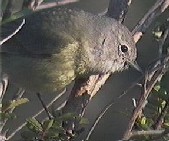
|
Orange-crowned Warbler |
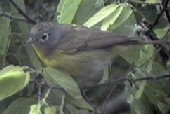
|
Nashville Warbler |
| |
Virginia's Warbler * |
| |
Lucy's Warbler * |
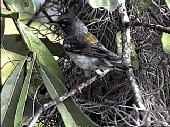
|
Northern Parula |

|
Tropical Parula *
The Tropical Parula nests no closer to Louisiana than the Lower Rio Grande Valley of Texas. It occurs in Louisiana strictly as a rarity. |
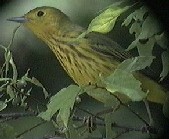
|
Yellow Warbler |
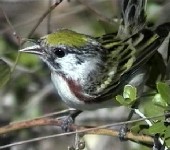
|
Chestnut-sided Warbler
The Chestnut-sided Warbler is a common to abundant Spring and Fall migrant through Louisiana. During Spring fallouts, hundreds may be seen in a
day's birding along the coast. Despite its occasional abundance, its beauty and the variety of colors it possesses in Spring, it drifts northward
through the state in relative obscurity due to its small size. In Fall, its colors are muted substantially, and it attracts even less notice. If only
more people would open their eyes! |
| |
Magnolia Warbler |
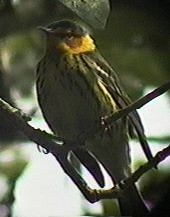
|
Cape May Warbler
Cape May Warblers are rare spring migrants. They seem to enter the state via the same pathway as Black-throated Blue Warblers, Black-whiskered Vireos
and Gray Kingbirds, i.e., on strong winds blowing west from the West Indies during migration. Under such conditions, presumably, a few are dispersed
slightly west of their normal West Indies-Florida route. Cape Mays are more common in the eastern half of the state, in such areas as Grand Isle, but
can also be found in most years in coastal Cameron Parish. |
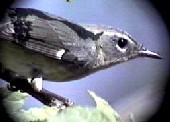
|
Black-throated Blue Warbler |

|
Yellow-rumped Warbler
The Yellow-rumped Warbler is not only the most common warbler in Louisiana, from late October to late March it probably outnumbers any other bird
species here. It can take advantage of almost any habitat and feeding style, whether that means picking at the mud near the edge of a marsh like a
sandpiper, flycatching like a phoebe, or hovering like a hummingbird. It is equally common in urban and rural settings and can be detected by its chip
even when it can't be seen. Amazingly, if you were to poll the people of Louisiana, most would tell you they have never seen one! This may not be
too surprising, as these warblers wear their drab winter plumage (which can be seen in the bird in the picture on the left) through most of their stay.
Only in March and April do they begin to molt into their brighter breeding colors.The Yellow-rumps found in Louisiana (such as the banded bird in breeding
plumage coming to the peanut butter feeder in the picture on the right) are the white-throated "Myrtle Warblers." The yellow-throated
"Audubon's Warbler" is rare at best in the state. |
| |
Black-throated Gray Warbler * |
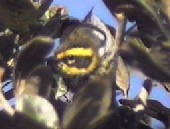
|
Townsend's Warbler * |
| |
Hermit Warbler * |
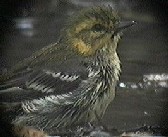
|
Black-throated Green Warbler |
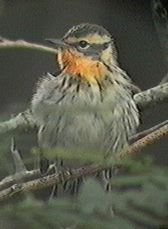
|
Blackburnian Warbler
Even among the warblers, a group known for their beautiful colors, the Blackburnian Warbler with its flame-orange throat is in a class by itself. At
coastal migration hotspots from mid-April through May, when a birder utters a gasp of amazement, it's likely to be followed by, "male
Blackburnian!" No picture or field guide can do it justice. Away from the coast in Spring, however, Blackburnians are less commonly encountered.
A good bet, however, is to search for pecans or hickories in flower. Among the migrants that sometimes flock to these trees, a Blackburnian can often
be found. Females (such as the one pictured here) are less brilliantly tinted, but still display enough of the Blackburnian pattern to be
identified. |
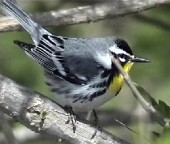
|
Yellow-throated Warbler |
| |
Pine Warbler |

|
Prairie Warbler |
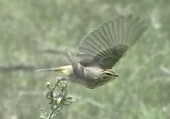
|
Palm Warbler
Palm Warblers are common to abundant Spring and Fall migrants, with a few remaining throughout the winter. The majority of our migrants, such as
the bird pictured here, are the drabber "Western" Palm Warblers, although a few of the brighter "Yellow" Palms can be found
here as well. |
| |
Bay-breasted Warbler |
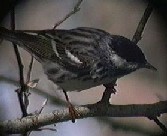
|
Blackpoll Warbler |
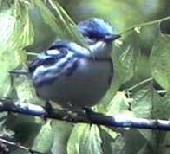
|
Cerulean Warbler
Although Lowery, in 'Louisiana Birds', lists the Cerulean Warbler as a "fairly common, occasionally abundant" spring migrant,
in my experience, it is uncommon to spot more than a few of these on a good birding day along the coast at that season. I have never encountered
a big fallout of this species, and my all-time daily high is certainly fewer than five. Ceruleans are early fall migrants, beginning to pass
through the state by mid-July on their way south. |
| |
Black-and-white Warbler |
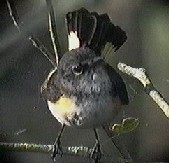
|
American Redstart |
| |
Prothonotary Warbler |
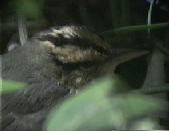
|
Worm-eating Warbler |
| |
Swainson's Warbler |
| |
Ovenbird |
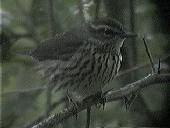
|
Northern Waterthrush
Northern Waterthrush is a common spring and fall migrant, generally passing through the state later in those seasons than Louisiana Waterthrush.
The two waterthrushes can be extremely similar. Good things to look for to separate Northern from Louisiana include (generally) much more densely
streaked underparts, fairly uniform off-white ground color beneath in Northern compared to very whitish ground color on the breast and throat with
buffy flanks and undertail in Louisiana. The throat is streaked on Northern, unstreaked white on Louisiana. The bill of Northern is noticeably
smaller than that Louisiana, and the legs are not as bright of a pink. The eye-stripe of Northern is usually dingy and narrows behind the eye in
Northern, and is whitish, and flares behind the eye in Louisiana. The eye-stripe differences aren't always as pronounced as field guides suggest,
unfortunately. |
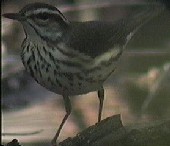
|
Louisiana Waterthrush |

|
Kentucky Warbler |
| |
Mourning Warbler |
| |
MacGillivray's Warbler * |
| |
Common Yellowthroat |
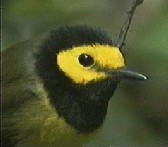
|
Hooded Warbler |
| |
Wilson's Warbler |
| |
Canada Warbler |
| |
Red-faced Warbler * |
| |
Painted Redstart * |